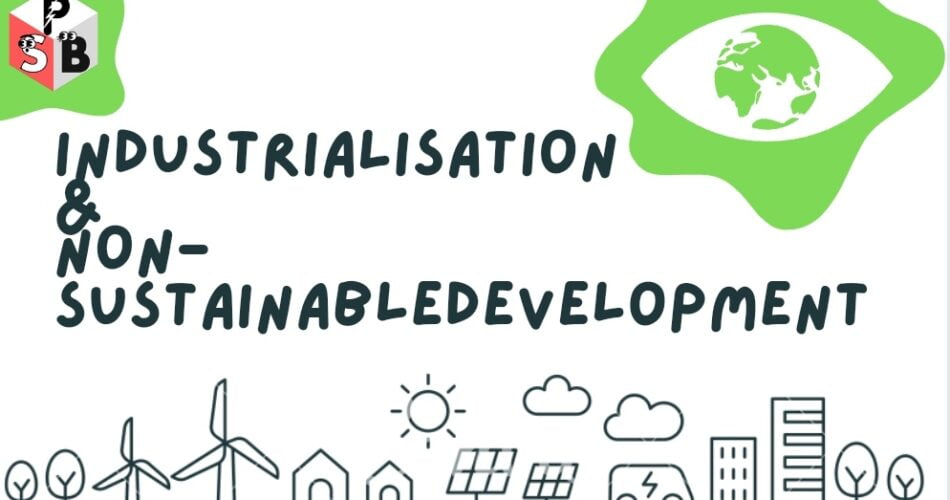Quantitative Growth of Economic Development
Industrialisation based on quantitative growth of mass production triggered off economic development in developed countries. Non-sustainable development is seen as the failure of growth-oriented policies, which focus only on quantitative production against the qualitative and holistic production benefiting people.
Traditionally the growth of a nation has been calculated in terms of Gross Domestic Product (GDP) and Gross National Product (GNP), which do not indicate that the nation is rich in culture and progressive in human values. These indicators focus mainly on tangible products and fail to calculate the value of the intangibles such as pollution effect on health, the value of the forests, loss in terms of animal and plant biodiversity and maintaining the groundwater recharge shed etc.
Studies made since the last phase of the United Nations (UN)-declared first development decade have shown that gross income growth does not always translate into poverty reduction. By the end of the last century, more than 1.3 billion people were living in developing countries who survived on less than the US $1/Day with increasing malnourishment, homelessness and deprivation.
The growth model has not taken care of the distribution of income globally. As a result, the poor have become poorer while the precious wealth has got locked up with the top 20% richest. Various disparities such as inequitable production, distribution and consumption have grown into massive proportions, making the poor vulnerable to the policies framed by the few rich at the top.
Industrial Revolution in England and Overuse or Exploitation of Environmental Resources
After the middle of the 18th century, England witnessed the beginning of the Industrial Revolution. It transformed Great Britain from a largely rural population living almost entirely in agriculture to a town-centred society engaged increasingly in factory manufacture. A series of inventions transformed the manufacture of cotton goods in England and gave rise to a new mode of production – the factory system.
During the years from 1750 to 1830, other branches of industry affected comparable advances, and all these together, mutually reinforcing one another, made possible further gains on an ever-widening front.
The abundance and variety of innovations may be included under three principles:
- The substitution of machines – rapid, regular, precise, tireless- for human skill and effort.
- The substitution of inanimate for animate sources of power, in particular, the introduction of engines for converting heat into work, thereby opening to man a new and abundant supply of energy.
- The use of new and far more abundant raw materials, particularly the substitution of minerals for vegetable or animal substances.
Other European nations underwent the same process soon after that, followed by others during the 19th century and others (such as Russia and Japan) in the first half of the 20th century. The Industrial Revolution was no sequence of changes in industrial techniques and production but a social revolution with social causes and profound social effects.
The Industrial Revolution implied that man now had not only the opportunity and the knowledge but also the physical means to subdue nature completely. But, while it brought its blessings, there was also much misery. Suppose we can thank the Industrial Revolution for giving us internal combustion engines and laser-guided radial arm saws. In that case, we can also condemn it for its threatening effect on social and ecological relationships.
The Industrial Revolution needed the resources, especially the raw materials, which were concentrated mainly in the now developing nations. While the resources were extracted from the Southern countries (presently the developing countries), the value addition was done primarily in the Northern countries (presently the developed countries), thus creating an economic imbalance.
The colonisation process also was responsible for exploiting natural resources of the ‘South’ for export, establishing large mono-cultures and opening up a largely unexploited domain. After independence, the newly established governments frequently paid more attention to rapid economic development than to fair and equitable access to natural resources.
From the 1950s onwards, Northern countries sought fast economic growth through state-managed industrialisation plans that led to excessive resource use and waste. The legacy of these forms of industrial production in the former Soviet Union and Eastern Europe has seen not only economic dislocation but also daunting environmental problems such as the death of the Aral Sea, nuclear contamination, and high levels of air and water pollution.
Since 1989, most such regimes have begun to move towards market-based systems of economic organisation and economic liberalisation, often accompanied by democratisation. While market systems have been inherently efficient in economic organisation, environmental costs have traditionally been excluded from decision-making. This has allowed unsustainable exploitation of natural resources and unsustainable demands on natural pollution sinks, like the tropical rain forests.
In 1991 the annual ‘product’ of the global economy was valued at $29,000 million, which meant it produced, in just 17 days, the equivalent of the entire annual global product a hundred years before. This has increased all forms of industrial activities such as energy generation, transportation, mechanical equipment and chemicals in agriculture, waste and effluent discharges and the release of harmful and hazardous gases in the air. This has led to high pollution levels and the extinction of several species from the earth.
The United Nations Environment Programme’s (UNEP) Red Data Book estimates that 25 per cent of species are about to face extinction as more than 100 species are becoming extinct every day. Unmindful industrialisation has also led to fatal accidents, as seen in Chernobyl, Exxon Valdez and Bhopal.
Sustainable development, therefore, is a reaction to the threatening speed of industrial activity undertaken by both rich and poor states.

